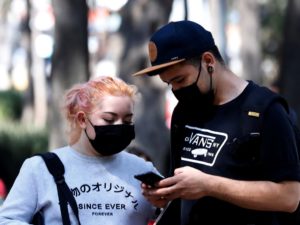Face Mask Protection:- A face mask may offer added protection against getting sick. There are no known risks to wearing these devices, except for the cost of buying them.
While masks seem promising, it’s also important to utilize other preventive measures, too.
Make sure you wash your hands often especially if you’re around others who may be sick. Also, be sure to get your annual flu shot to protect yourself and others from spreading the virus.
When the United States experienced an outbreak of the swine flu in 2009, everyone was talking about how to reduce the spread of the virus.
According to the Centers for Disease Control and Prevention (CDC), vaccine availability was limited that year because the virus wasn’t identified until manufacturers had already started producing the annual vaccine.
So, people started doing something most of us hadn’t really seen before to stop transmission: wearing surgical face masks.
But with the recent spread of the novel coronavirus SARS-CoV-2, people are again looking to surgical face masks as a way of protecting themselves and others from the virus, which causes the disease COVID-19.
But does wearing a face mask really prevent the spread of viruses, such as the flu or SARS-CoV-2?
We’ll look at recommendations from experts, unpack the research on which masks are most effective, and explain how to use masks properly. Face Mask Protection
Contents
Different types of masks
If you’re considering wearing a mask to protect yourself against infections, there are three types you should know about.
Surgical face masks
Surgical face masks are fairly loose-fitting, disposable masks approved by the Food and Drug Administration for use as medical devices. Doctors, dentists, and nurses often wear them while treating patients.
These masks prevent large droplets of bodily fluids that may contain viruses or other germs from escaping via the nose and mouth. They also protect against splashes and sprays from other people, such as those from sneezes and coughs.
But the average masks you can buy from a local drugstore aren’t enough to filter out viruses.
For that purpose, experts recommend special masks with fine mesh that can capture very small organisms. These also have to be worn correctly for them to work.
Masks worn over the face are also unable to protect you from getting airborne virus particles, from a cough or sneeze, into your eyes.
Respirators
Respirators, also called N95 respirator masks, are designed to protect the wearer from small particles in the air, like viruses. They’re certified by the CDC and National Institute for Occupational Safety and Health.
The name comes from the fact that they can filter 95 percent of airborne particles, according to the CDC. N95 masks are also often used when painting or handling potentially toxic materials.
Respirators are selected to fit your face. They must form a perfect seal so no gaps allow airborne viruses in. Healthcare workers use them to protect against airborne infectious diseases, such as tuberculosis and anthrax.
Unlike regular face masks, respirators protect against both large and small particles.
Overall, respirators are considered much more effective at preventing the flu virus than regular face masks.
Still, studies have found benefits to both types of masks.
Cloth face coverings or masks
Cloth face coverings or masks can be used in public settings, such as grocery stores, where you may be in close contact with others and it’s difficult to maintain your distance.
They don’t offer the same level of protection as surgical face masks or respirators. However, when worn by the public at large, they can still help reduce the community spread of viruses. This is because they help prevent people without symptoms from transmitting viruses via their respiratory droplets.
You can make your own at home using a few basic materials, such as cotton fabric, a T-shirt, or a bandana. The CDC includes instructions for sewing your own with a machine as well as two no-sew methods.
They should fit snugly against the face, covering both your nose and mouth. Also, use ties or ear loops to keep them secure.
When removing the cloth face mask, try to avoid touching your nose, mouth, and eyes.
Cloth face masks shouldn’t be used by children under 2 years old, people who have trouble breathing, and people who are unable to remove their own masks.
What do the experts say?
In the case of the novel coronavirus and COVID-19, the CDC notes that simple face coverings or masks can reduce its spread:
“CDC recommends that people wear a cloth face covering to cover their nose and mouth in the community setting. This is an additional public health measure people should take to reduce the spread of COVID-19 in addition to (not instead of) social distancing, frequent hand cleaning and other everyday preventive actions.”
The CDC recommends healthcare workers wear face masks when working with patients who have the flu.
The CDC also recommends patients who show signs of respiratory infections be given masks while they’re in healthcare settings until they can be isolated. Face Mask Protection
If you’re sick and need to be around others, properly wearing a mask can protect those around you from contracting your illness.
Studies show masks may help in some cases
For many years, scientists weren’t sure whether wearing a mask was effective at preventing the spread of viruses. However, recent studies suggest they can help.
One 2013 study looked at how masks could help people with the seasonal flu limit spreading it when they exhale small droplets containing the virus. Overall, researchers found masks led to a more than threefold reduction in how much virus people sprayed into the air.
Another study, analyzing data from thousands of Japanese schoolchildren, found that “vaccination and wearing a mask reduced the likelihood of developing seasonal influenza.”
Importantly, researchers also found that flu rates were lower when masks were paired with proper hand hygiene.
In other words, regular hand washing remains an essential tool in preventing the spread of viruses.
Guidelines for wearing face masks
While face masks can help reduce the spread of the flu and other respiratory viruses, they only do so if worn correctly and frequently.
Here are some guidelines for proper mask-wearing:
- Wear a face mask when coming within 6 feet of a sick person.
- Position the strings to keep the mask firmly in place over the nose, mouth, and chin. Try not to touch the mask again until you remove it.
- Wear a face mask before going near other people if you have the flu.
- If you have the flu and need to see a doctor, wear a face mask to protect others in the waiting area.
- Consider wearing a mask in crowded settings if the flu is widespread in your community, or if you’re at high risk for flu complications.
- When you’re done wearing a surgical face mask or respirator, throw it away and wash your hands. Never reuse it.
- Wash your cloth face mask after each use.


